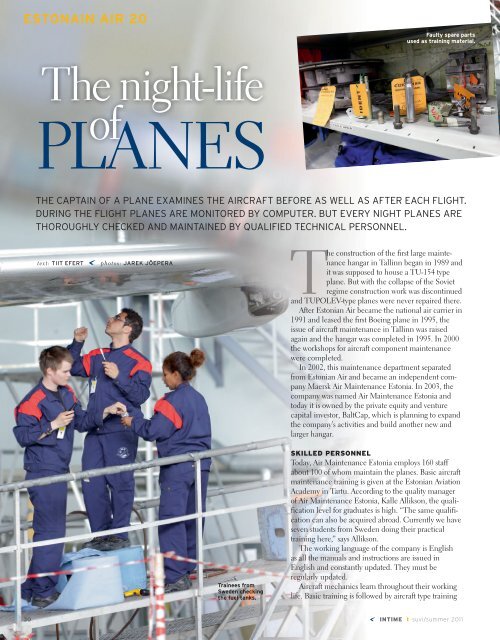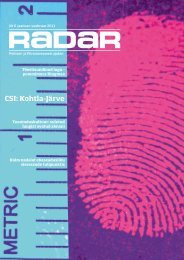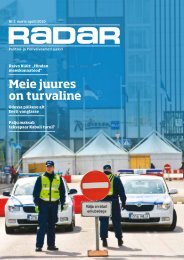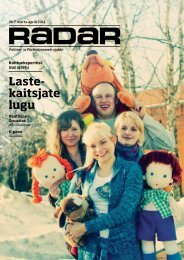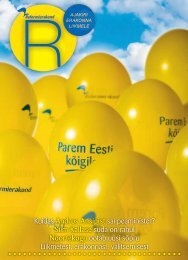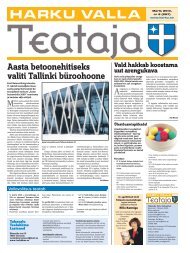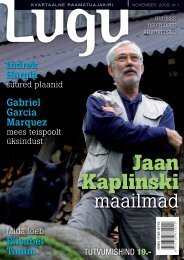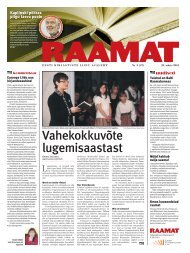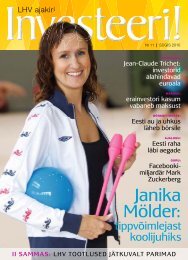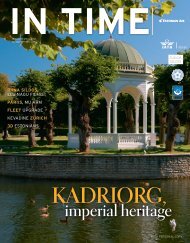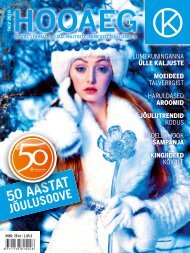IN TIME
rubriik - Profimeedia
rubriik - Profimeedia
- No tags were found...
Create successful ePaper yourself
Turn your PDF publications into a flip-book with our unique Google optimized e-Paper software.
EsToNaiN air 20<br />
faulty spare parts<br />
used as training material.<br />
The night-life<br />
of<br />
PlanEs<br />
THE CAPTA<strong>IN</strong> Of A PLANE ExAM<strong>IN</strong>ES THE AIRCRAfT bEfORE AS WELL AS AfTER EACH fLIgHT.<br />
duR<strong>IN</strong>g THE fLIgHT PLANES ARE MONITOREd bY COMPuTER. buT EVERY NIgHT PLANES ARE<br />
THOROugHLY CHECKEd ANd MA<strong>IN</strong>TA<strong>IN</strong>Ed bY QuALIfIEd TECHNICAL PERSONNEL.<br />
text: tiit efert<br />
photos: jarek jõepera<br />
The construction of the first large maintenance<br />
hangar in Tallinn began in 1989 and<br />
it was supposed to house a TU-154 type<br />
plane. But with the collapse of the Soviet<br />
regime construction work was discontinued<br />
and TUPOLEV-type planes were never repaired there.<br />
After Estonian Air became the national air carrier in<br />
1991 and leased the first Boeing plane in 1995, the<br />
issue of aircraft maintenance in Tallinn was raised<br />
again and the hangar was completed in 1995. In 2000<br />
the workshops for aircraft component maintenance<br />
were completed.<br />
In 2002, this maintenance department separated<br />
from Estonian Air and became an independent company<br />
Maersk Air Maintenance Estonia. In 2003, the<br />
company was named Air Maintenance Estonia and<br />
today it is owned by the private equity and venture<br />
capital investor, BaltCap, which is planning to expand<br />
the company’s activities and build another new and<br />
larger hangar.<br />
Trainees from<br />
sweden checking<br />
the fuel tanks.<br />
skIllEd pErsoNNEl<br />
Today, Air Maintenance Estonia employs 160 staff<br />
about 100 of whom maintain the planes. Basic aircraft<br />
maintenance training is given at the Estonian Aviation<br />
Academy in Tartu. According to the quality manager<br />
of Air Maintenance Estonia, Kalle Allikson, the qualification<br />
level for graduates is high. “The same qualification<br />
can also be acquired abroad. Currently we have<br />
seven students from Sweden doing their practical<br />
training here,” says Allikson.<br />
The working language of the company is English<br />
as all the manuals and instructions are issued in<br />
English and constantly updated. They must be<br />
regularly updated.<br />
Aircraft mechanics learn throughout their working<br />
life. Basic training is followed by aircraft type training<br />
30<br />
<strong>IN</strong><strong>TIME</strong> I suvi/summer 2011


